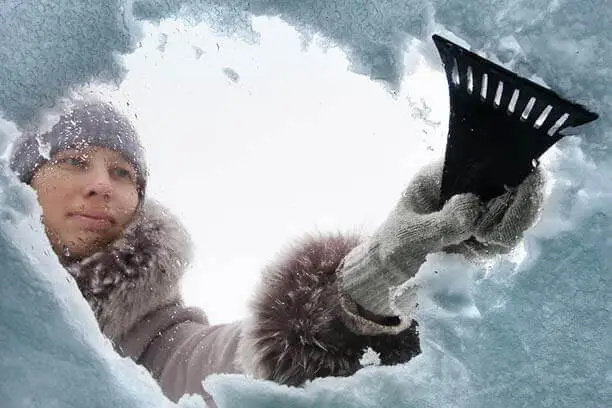Winter Car Tips: Car Maintenance to Tackle Before Winter


A winterized car is a safe car. Here are eight winter car tips to get your vehicle ready for a season of snow, ice, slush and rain.
If your tires’ tread is worn down, your car’s stopping distances will be longer on slippery roads, ice and snow, and resistance to hydroplaning will be reduced. To determine whether there is enough tread on your tires, take a penny and insert it into one of the grooves between the treads. Lincoln’s head needs to be facing you and his head should be upside down. Do this in 10-15 areas of the tire. If you see all of Lincoln’s head, the tread depth is less than 2/32 of an inch, meaning the tire isn’t safe and needs to be replaced.
During winter, 10 degrees can feel like a big difference, and it can for your tires, too. Did you know that every 10 degrees change can mean a gain or loss of 1 PSI on tires? That means you should check your tire pressure more regularly during the winter and refill your tires if needed. Can’t remember how to inflate them? Check your vehicle owner’s manual or the place card in the driver’s side door for instructions. Also, know the age of your tires. Tires should be rotated every 3,000 to 6,000 miles to help them wear more evenly and last longer.
This may be one of the most overlooked winterizing tips each year. Chemical reactions within the battery make electricity slow down as the temperature drops, making it difficult for it to produce max power in the cold. Most car batteries need to be replaced every three to five years. Is yours due for a change?
Imagine pushing a stalled vehicle out of traffic because you’ve run out of gas. Now, imagine it during a cold, blustery, single-digit temp night with stinging wind biting you in the face. It’s not fun, and it certainly isn’t safe. Make sure you keep your gas tank at least half full to prevent gas line freeze ups.
People who live in snowy areas often equip their vehicles with all-season tires without When temperatures continually hover around or below freezing, the rubber compounds in non-winter tires harden, decreasing the grip on the road. Enter, winter tires. “Winter” or “snow tires” are made to withstand icy and snowy roads by keeping better tread grip and road contact during these conditions. The tread on snow tires is designed with special patterns which allow the tires to dig into snow and ice.
While it’s important to know what’s going on in front of you on an icy roadway, it’s just as important to know what’s going on behind you, too. Make sure to winterize your rear-window defroster by checking to see if is working properly because it can create unsafe driving conditions. In fact, several state laws state that all your windows must be clear of condensation and debris.
Sometimes called antifreeze, coolant is a liquid that absorbs engine heat and dissipates that energy through the radiator. It cools the engine in the winter and summer, preventing overheating and extensive, expensive damage to the engine. The coolant also is formulated to resist freezing.
Snow, slush, and salt can quickly build up on the windshield, blinding a driver if the wiper blades are worn out. Replace the wipers if they look dry and brittle or leave streaks of liquid on the windshield.
When the forecast calls for snow, sleet or ice, the safest course of action is to stay off the roads. But when there’s somewhere you need to be, use these tips to help you get there safely.
Before the snow is even in the forecast, take your car in for recommended car maintenance to ensure it’s in top condition to handle winter driving. Make sure the heater is in good working condition, and winter tires are installed if needed.
Use this checklist for packing all the emergency essentials before heading out.
Before you venture out, check your state’s Department of Transportation (DOT) website to get the scoop on road conditions. Keep in mind that even partially snow-covered roads can pose a driving hazard, so it’s important to exercise caution.
Ask your insurance agent about adding emergency roadside assistance coverage to your auto policy, so you have reliable help when you need it.
Concentrate on the road, and that means eliminating driving distractions. Take the extra time to make sure your visibility isn’t compromised by frost, ice or snow. Put away your phone, turn off the music, and ask your travel companions to keep their voices down. Keep your hands on the wheel, and your eyes on the road.
Not only do you need to focus on your driving, but you also need to be alert and aware of the cars around you. Don’t use your cruise control and try to avoid sudden stops and quick direction changes. Be extra cautious on bridges, ramps and overpasses, as they may freeze first. And remember this rule — if your wipers are on, your lights should be on, too.
Whether you embrace the cold weather and snow or are counting down the days until summer, make sure you connect with a farm bureau agent and protect yourself on the road.